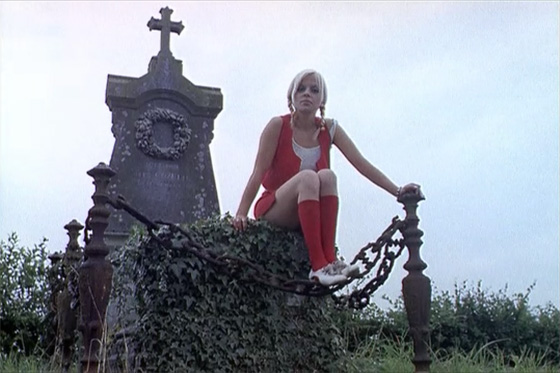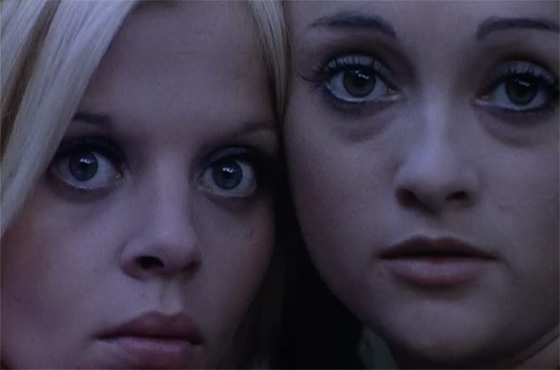
This, Jean Rollin’s fourth vampire film, would be his last for a while – he would try something artsier next, before getting sidelined into the sexploitation market. You can begin to see that grindhouse pull with Requiem for a Vampire (1972), which is notably sleazier than his earlier offerings. On the other hand, it’s also more experimental – most of the film contains no dialogue whatsoever, and relies solely upon its dream-like visuals. These are the two sides of Jean Rollin, clashing more strongly than ever: a need to meet seedier commercial requirements (consider the kinds of theaters where his films typically played), and a need to satisfy his own unique muse. In an interview published in the Fall 1973 issue of Cinefantastique, he said that for his first film, Rape of the Vampire (1968), the sexploitation element was imposed on him by the producer and distributor: “We were given a simple ultimatum: if you want your film released, we can release it on the sex circuit. They wouldn’t think of attempting a pure horror film.” He boasted, “As I didn’t intend it for the sex circuit, I prefer Requiem pour un vampire. It may be the last one. In its ninety minutes there are only four or five minutes of eroticism, only two scenes really. During the first hour of the film there is no dialogue, only music and sound effects.” What he didn’t explain was that the nature of those “four or five minutes” (which is a conservative estimate) are much more intense and uncomfortable than what he had filmed in the past. (The picture would be released in some markets as Caged Virgins.) Nonetheless, a great deal of the piece has that melancholy, wistful tone common in his work, and many Rollin fans consider it their favorite of his vampire cycle.
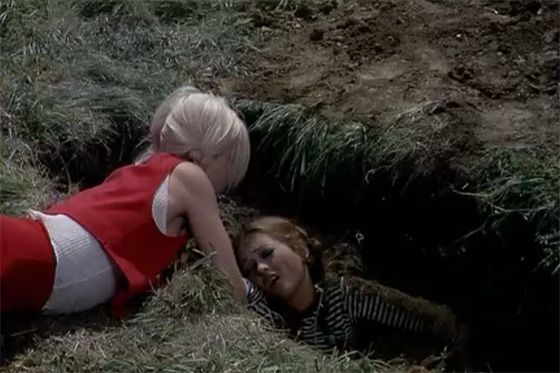
Marie (Marie-Pierre Castel) rescues Michelle (Mireille Dargent) from being buried alive by gravediggers.
Though his first three films seem to exist in the same endless loop of graveyards, castles, and beaches, the opening scene of Requiem for a Vampire is a jarring change of pace. A woman in a clown costume and makeup is firing a gun out of the shattered rear window of a speeding car. The driver is bleeding profusely, and next to him is another young woman dressed as a clown. Gunfire is exchanged with the car in pursuit. (But, seeing as this is a semi-artsy French film, the two cars are shooting at each other from a very short distance, interminably and with no progress, and they’re maybe driving about thirty-five miles an hour, max. Jean-Luc Godard might have directed this “action” scene.) They lose their tail by taking a side road into a forest, but the driver abruptly dies, leaving the two girls to douse his body with gasoline and set fire to him and the car. After wandering through the woods, they change into sexy little outfits and steal a motorcycle. A misadventure in a cemetery almost leads to the brunette, Michelle (Mireille Dargent), getting accidentally buried alive by some careless gravediggers – the blonde Marie (played by one-half of the Castel twins from The Nude Vampire, Marie-Pierre), rescues her at the last moment. It’s foreshadowing. Soon they encounter a castle, which they presume abandoned, until they realize they’ve stirred a nest of vampires – including one played by Dominique, the gaunt, clock-dwelling vampiress from Shiver of the Vampires. The vampires are looking for some virgins to join their cause and extend their race. The two girls are mesmerized and given their first mission: to seduce some men back to the castle so they can be slaughtered and feasted upon. Michelle follows her orders to the letter, and drinks the blood of her kill, but Marie disobeys – she lets the first one she meets, Frédéric, take her virginity. As it happens, this supports the strategy of an old man in a cape dwelling in the castle mausoleum, who is a true vampire living amongst pretenders. Conspiring against the cult that inhabits his castle, he seeks to end his bloodline once and for all.
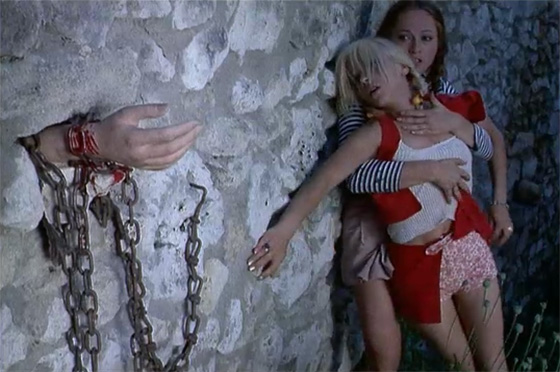
Just one of the many strange sights in Jean Rollin's castle of horrors.
If Requiem for a Vampire is even more of a stylistic experiment than its predecessors, it also continues the trend of telling simpler, more coherent stories. It unfolds like an adult, erotic fable. Marie and Michelle are lesbian lovers (there’s a tentative, quickly-aborted attempt at a love scene). Michelle is genuinely hurt that Marie surrenders her virginity rather than committing to life as an immortal vampire. As another of Requiem‘s many conundrums, one of its most exploitative scenes is also its most strangely touching: Michelle is ordered to whip the nude body of her chained-up friend until she confesses where she’s hiding Frédéric. As Michelle pleads with Marie to please talk so she can stop torturing her – or they’ll both be killed – Rollin shoots a close-up of Mireille Dargent’s moon-like face, the tears streaming down in rivulets like blood from a wound. The torture chamber is a sickly, glowing green; Rollin here continues the expressionistic use of color begun with The Nude Vampire. He lights the film’s most grotesque sequence in a deep red: the prolonged (way too long) torture and rape of female captives by the brutish male servants of the vampires. The final, quasi-surrealistic shot of this scene is a vampire bat clamped upon a woman’s genitals. So yep, that’s been put on celluloid – thanks.
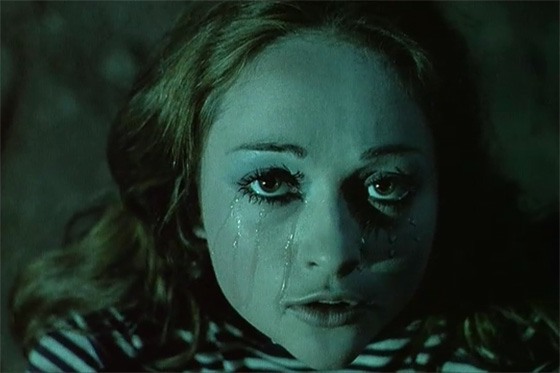
Michelle pleads to Marie - while whipping her - in the castle torture chamber.
But the ending is so muted, almost tragic; of all the titles under which this film was distributed, Rollin preferred Requiem for a Vampire, perhaps because it points toward the solemn tone of that final scene in which the old vampire retires to his mausoleum to die, while one of his servants, compelled to obey his every command, sits against her will to guard the door. This was the kind of film Rollin really wanted to make. “The more people who can acquire the backing to make cinefantastique, the better it will become,” he said in 1972. “We must find a way to eliminate the erotic element that is imposed upon us. But it is very difficult to make fantasy films here. It is a genre which is despised. The pure fantasy film, without explicit blood and gore, is difficult to achieve successfully. I have tried, but I have failed. The burning question that needs answering is, is there a public for such films?” I suspect Rollin was a bit too defensive, in his efforts to have his films taken seriously by critics who’d rather be reviewing the likes of Godard and Truffaut. We can see now that Rollin never completely excised the erotic from his work, in his long and prolific career; it became integrated into his personal style. In his best films, such as Shiver of the Vampires and Fascination (1979), the sexual theme is indispensable, and certainly a valid subject for thoughtful exploration. Requiem for a Vampire at times crosses the line into sleaze, but in its best moments, the erotic is powerful. Rollin was still experimenting with making this approach work, and those experiments would bear some fruit in the films to come – even as his career would become increasingly fractured. The future, for Rollin, would hold a pure “art” film (The Iron Rose, 1973), as well as both softcore and hardcore pornography (for money, and under a pseudonym). Perhaps he was never destined for a wide critical appreciation, but a cult following as exclusive as those he depicted on film.
